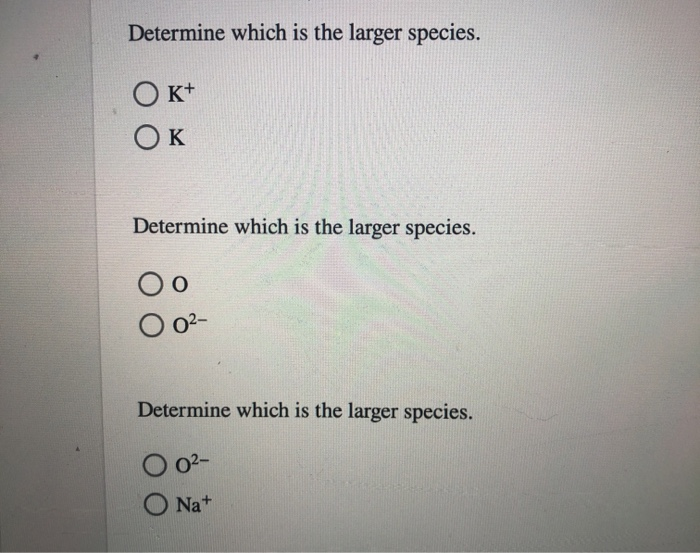QQuestionAnatomy and Physiology
QuestionAnatomy and Physiology
Determine which is the larger species.
$\bigcirc \mathrm{K}^{+}$
$\bigcirc \mathrm{K}$
Determine which is the larger species.
$\bigcirc \mathrm{O}$
$\bigcirc \mathrm{O}^{2 -}$
Determine which is the larger species.
$\bigcirc \mathrm{O}^{2 -}$
$\bigcirc \mathrm{Na}^{+}$
Attachments

6 months agoReport content
Answer
Full Solution Locked
Sign in to view the complete step-by-step solution and unlock all study resources.
Step 1: Recall that ions are atoms or molecules that have gained or lost electrons, resulting in a net charge.
The size of an ion is influenced by its charge and the number of electrons in its outermost energy level.
Step 2: Compare the sizes of $\mathrm{K}^{+}$ and $\mathrm{K}$.
Potassium $\mathrm{K}$ is an alkali metal with one electron in its outermost energy level.
When it loses this electron to form $\mathrm{K}^{+}$, the remaining electrons occupy a smaller volume, making the $\mathrm{K}^{+}$ ion smaller than the neutral $\mathrm{K}$ atom.
Final Answer
Step 3: Compare the sizes of $\mathrm{O}$ and $\mathrm{O}^{2 -}$. Oxygen is a chalcogen with six electrons in its outermost energy level. When it gains two electrons to form $\mathrm{O}^{2 -}$, the added electrons occupy a larger volume, making the $\mathrm{O}^{2 -}$ ion larger than the neutral $\mathrm{O}$ atom. Step 4: Compare the sizes of $\mathrm{O}^{2 -}$ and $\mathrm{Na}^{+}$. Sodium $\mathrm{Na}$ is an alkali metal with one electron in its outermost energy level. When it loses this electron to form $\mathrm{Na}^{+}$, the remaining electrons occupy a smaller volume. Oxygen $\mathrm{O}^{2 -}$ has gained two electrons, causing the added electrons to occupy a larger volume. As a result, the $\mathrm{O}^{2 -}$ ion is larger than the $\mathrm{Na}^{+}$ ion.
Need Help with Homework?
Stuck on a difficult problem? We've got you covered:
- Post your question or upload an image
- Get instant step-by-step solutions
- Learn from our AI and community of students